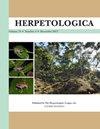追逐甘蔗蟾蜍:评估佛罗里达州核心和边缘种群蟾蜍的运动差异
IF 1.1
3区 生物学
Q2 ZOOLOGY
引用次数: 0
摘要
摘要:甘蔗蟾蜍(Rhinella marina)是一种引入美国佛罗里达州南部的入侵物种,种群已在该州向北扩散。据预测,在其分布扩大边缘附近建立的种群比长期建立的种群具有更大的耐力,这是扩散能力的一个指标。为了评估耐力,我们从佛罗里达州的北部(边缘)和南部(核心)种群中收集了蟾蜍,将它们放在跑道上,并鼓励它们跳跃。记录了蟾蜍在轨道上的敲击次数、跳跃次数和跳跃时间,以及每只蟾蜍移动的总距离。边缘种群蟾蜍不太愿意移动,也不像核心种群蟾蜍那样在轨道上移动得那么远。为了进一步评估耐力,我们在跑步机内放置了一组额外的蟾蜍,在跑步机上需要运动来保持平衡。蟾蜍在跑步机上移动,直到筋疲力尽。我们测量了每只蟾蜍在衰竭时和3小时恢复期的血液乳酸水平。在跑步机试验后,蟾蜍的行走距离没有受到种群影响。当蟾蜍精疲力竭或恢复时,种群对其乳酸水平也没有影响。总体而言,在这项研究中,我们采样的北部边缘种群的蟾蜍与采样的南部种群的蟾蜍相比,其耐力没有差异。这一发现可能表明,在佛罗里达州最北端的蟾蜍种群中,进一步的扩散是有限的。此外,蟾蜍不愿在赛道试验中移动,这可能表明佛罗里达州边缘人群的选择压力不同。本文章由计算机程序翻译,如有差异,请以英文原文为准。
Chasing Cane Toads: Assessing Locomotory Differences in Toads from Core and Edge Populations in Florida
Abstract: Cane Toads (Rhinella marina) are an invasive species introduced to southern Florida, USA, and populations have spread northward through the state. Populations established near expanding edges of their distributions are predicted to have greater endurance, an indicator of dispersal capability, than longer established populations. To assess endurance, we collected Cane Toads from a northern (edge) and southern (core) population in Florida, placed them into a track, and prodded them to hop. The number of prods (taps), hops, and time spent hopping were recorded, along with the total distance each toad moved on the track. Edge population toads were less willing to move and did not travel as far in the track as those from the core population. To further evaluate endurance, we placed an additional set of toads inside a treadmill, where movement was required to maintain equilibrium. Toads moved on the treadmill until reaching exhaustion. We measured blood lactate levels from each toad upon exhaustion and during a 3-h recovery period. After the treadmill trials, there was no population effect on the distances traveled by toads. There was also no population effect on lactate levels of toads when reaching exhaustion or during recovery. Overall, Cane Toads from our sampled northern edge population showed no differences in endurance compared to those sampled from the southern population in this study. This finding may indicate that further dispersal is limited in the northernmost populations of the Cane Toad range in Florida. Furthermore, the reluctance of Cane Toads to move in the track trials may indicate that selective pressures differ for edge populations in Florida.
求助全文
通过发布文献求助,成功后即可免费获取论文全文。
去求助
来源期刊

Herpetologica
生物-动物学
CiteScore
4.60
自引率
0.00%
发文量
27
审稿时长
>12 weeks
期刊介绍:
Established in 1936, Herpetologica is a quarterly peer-reviewed journal serving herpetologists, biologists, ecologists, conservationists, researchers and the scientific community. The journal contains original research papers and essays about the biology of reptiles and amphibians, and covers many relevant topics including: behavior, conservation, ecology, genetics, morphology, physiology and taxonomy.
 求助内容:
求助内容: 应助结果提醒方式:
应助结果提醒方式:


